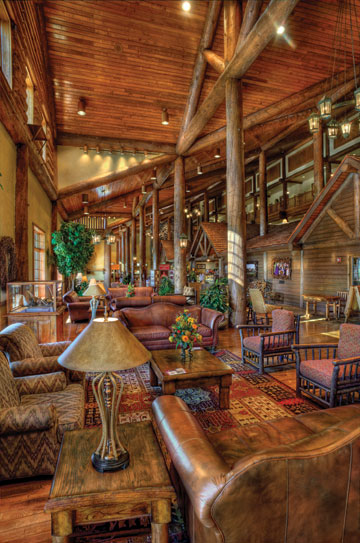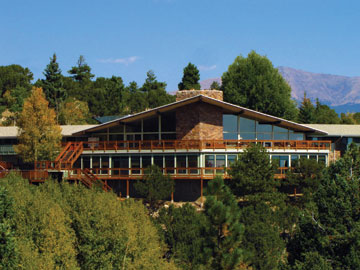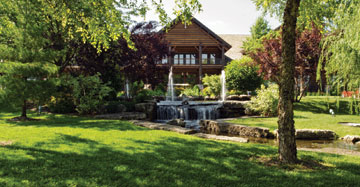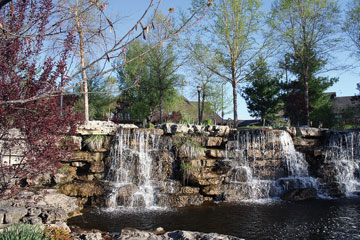
By Ronald E. Keener
Participants don’t want to ‘rough it’ as much, look for comforts of home.
 The idea of taking some time to walk away from the pressures of everyday life to reconnect on a deeper level with God is as old as Christianity itself. The practice is still going strong today, and for those who set aside the time for this experience, the rewards are many.
The idea of taking some time to walk away from the pressures of everyday life to reconnect on a deeper level with God is as old as Christianity itself. The practice is still going strong today, and for those who set aside the time for this experience, the rewards are many.
“We see more community type retreats for men, women or couples,” says Tim Beardon, senior manager of the Tennessee Baptist Conference Center. “Our Carson Springs camp has a retreat for senior adults.”
“I would say about 80 percent of our guests are repeat visitors,” adds Beardon. Tennessee Baptist Conference Centers runs two camps in the state, Linden Valley and Carson Springs. They are typical of many facilities that offer youth and family camping activities during the summer and then focus on conferences and retreats from Labor Day to Memorial Day.
That is the pattern at Young Life’s Trail West Lodge in Buena Vista, CO. The summers are dedicated to full weeks of family-oriented, all-inclusive fun woven with Young Life’s renowned presentation of the Gospel. The rest of the year the facility welcomes church, parachurch and other groups for a retreat experience set against the backdrop of spectacular Rocky Mountain scenery.
Brian Phillips, marketing manager for Young Life’s cluster of Colorado camps, recalls the impression Trail West made on a first-time visitor, who felt the spirituality of the place was “palpable.” Phillips says the guest told him he could feel, “ … the Kingdom’s work being done.”
Young Life operates 26 camps and conference centers across the continent catering strictly to groups. “We typically don’t do the programming,” says Phillips. “Every organization is different, and they organize their own programming.”
In addition to inspirational settings, comfortable accommodations and quality food services, Young Life can offer these amenities at reasonable prices. “As a non-profit,” Phillips points out, “we charge no use tax and accept no gratuities. That’s where being a Christian camp offers an advantage.”
Trail West hosts some special guests every year — a group of freshmen from the U.S. Air Force Academy in Colorado Springs. “There is a chaplain’s retreat for the freshmen, the ‘doolies’ they call them,” Phillips says. “It’s their first opportunity to get off campus, and the chaplain always has 100 percent attendance.”
You can’t find a television set at any Young Life camp, nor could you at the Tennessee Baptist facilities. Getting away from that sort of distraction is part of the point. But what about smart phones and tablets and such? Phillips says the groups themselves have to set those rules.
Not all retreats happen in a group setting. There are facilities catering to individuals and others offering the right ingredients for either personal or group retreats.
 That is certainly the case at the Keeter Center’s Mabee Lodge, a facility located on the campus of the College of the Ozarks, just a short ride down the road from Branson, MO. The historic 15-room lodge offers meeting rooms, a 350-seat conference center and suites accommodating up to six people, all nestled amidst Ozark Mountain scenery. There are peaceful walking paths and opportunities for quiet contemplation for visitors seeking respite from their daily lives.
That is certainly the case at the Keeter Center’s Mabee Lodge, a facility located on the campus of the College of the Ozarks, just a short ride down the road from Branson, MO. The historic 15-room lodge offers meeting rooms, a 350-seat conference center and suites accommodating up to six people, all nestled amidst Ozark Mountain scenery. There are peaceful walking paths and opportunities for quiet contemplation for visitors seeking respite from their daily lives.
Guests at the lodge certainly won’t be roughing it. Operated and staffed by students at the college, the Keeter Center earns rave reviews for its service and cuisine.
Comfortable and appealing facilities
In May of last year the Presbyterian Church (USA) surveyed 2,100 of their people and discovered that “a substantial majority are very or somewhat likely to attend a retreat or camp activity that their congregation organizes or publicizes.”
Presbyterians are also looking for facilities that are comfortable and appealing. The survey says they expect indoor sleeping facilities, central heating, private baths, air conditioning, and meals provided by the host facility. Joel Winchip, executive director of the denomination’s Camp and Conference Association, says “where some centers might have offered hall or shared bathrooms 10 or 20 years ago, most retreat guests are now seeking private bath bedrooms.”
Presbyterians have 150 camps and conference centers across the country, and Winchip says that “some centers offer activities like mission work experiences that give retreat participants an opportunity to serve God by helping others. You don’t have to plan a trip to another country to help people in need.”
Conference and retreat centers are reaching out more to congregations, says Kevin Witt, who heads the program for the United Methodist Church. “A growing number of retreat centers are now broadening their service to local churches by planning retreats with them that meet their specific need, rather than simply providing facilities or planning a more generic retreat program,” he reports.
“This connection with a congregation’s specific strategic plan for growth in Christian discipleship, closeness to God, the development of spiritual leaders, renewal, community building, outreach, and implementation of other ministry goals through retreats brings the unparalleled benefits of retreats into the core faith forming process of a congregation,” Witt says.
He says that nearly all centers see local churches as partners in ministry rather than simply as a guest group using the facilities, which is very different from many hotel settings. “Over the next five years, there is likely to be more retreats involving leaders of new church starts and churches involved in the church vitalization movement, now a major priority of many denominations,” he says.
 Witt also sees the need to reach out to that part of society that are spiritual but not religious.“Some retreat ministries,” he admits, “are thriving and others are struggling to make the needed transitions.”
Witt also sees the need to reach out to that part of society that are spiritual but not religious.“Some retreat ministries,” he admits, “are thriving and others are struggling to make the needed transitions.”
Larger churches are engaged in a model that develop retreats and open them up as a program of the denomination in the region in which they live “by working in concert with judicatory leaders and camp and retreat ministry teams.” The most effective models, he notes, “draw people together for specific purposes based on life stages, situations they may be facing, common activities or interests they enjoy, Christian growth based on specific spiritual practices or topics, education and leader training, renewal and fellowship, planning, strengthening relationships and families, and more.”
He says that the large church provides the core planning team and then invites other churches in the area or the camp and retreat ministry staff to join them in co-planning an event that will have broader appeal. Not only are smaller churches engaged when they could not do it alone, but they are trained in retreat leadership.
“Many large churches probably have the talent and resources to do retreats on their own, but their involvement with other congregations and the wider denomination becomes a powerful outreach ministry.” Witt says. The Methodists have 223 camp and retreat centers in the U.S. and more in other countries, all regionally or locally owned. They serve nearly a million guests and participants in adult retreats and camp programs for all ages.
Presbyterian Church’s Winchip observes that often the first program of a congregation to be cut when the budget gets tight are church retreats. Yet, he says, “the retreat experience may be the most powerful tool the church has for creating real and lasting connections between old and new members of the congregation. The bonds that are formed during a retreat bring a church closer together and allows the participants to focus on the message.”
Winchip says the denomination has created the BookARetreat.com search engine that allows retreat planners to search the country for the best facility based on location and lodging needs.
________________________________________________
How to craft a personal retreat
One of the questions I’m asked whenever I talk about a personal retreat is, “What do you actually do there?” Some of you might be asking the same thing. Read on before you walk into your next elder’s meeting to ask for the time off.
You can structure your week/month in a way that fits where you are. I’ve always used it holistically – as a time to pay attention to the personal, spiritual and “professional” aspects of my life. Here’s what a retreat isn’t:
- A monastic retreat
- A work camp
- A spa
- A vacation
It’s a personal retreat. The reason we have so much difficulty figuring it out is because it’s a concept largely foreign to us. While it’s none of the aforementioned things exclusively, it contains elements of work, rest, spiritual renewal and intense reflection. Some years, certain things need to be emphasized more than others. Allow me to sketch what I try to do over a week:
Rest: No alarm clock. I go to bed when I’m done for the day, and get up when I’m ready. Ironically, I can’t recall ever sleeping more than eight hours in any given day. However, I have three young children and a busy schedule, so eight uninterrupted hours feels like 16. For the first time in at least a couple of years, I saw no dark circles under my eyes when I looked in the mirror. Sleep changes all sorts of things. I also choose serene environments with inclement weather. I usually go to Princeton in late November or early December. It’s freezing and boring from an entertainment perspective. I do it so it will help me focus. I stay in the seminary dorms. The accommodations are adequate, but quite Spartan. It’s also finals time and the only stuff going on is Advent/Christmas related. So, it’s spiritually nourishing, but keeps me indoors and free from distraction.
Reflection: I probably average three hours a day thinking and praying about my walk with God, life at home and emotional well-being. I try to be as brutally honest before God and the mirror as I can. How is my purity? How is my relationship with each of my daughters? How is my prayer life? How are we doing with money? Do I have emotional needs that aren’t being met? I then write observations and action steps (if they exist) to help improve things or continue the positive things. Then, I spend time in prayer. One word of encouragement: spend at least half of your time counting blessings and thanking God for what he’s doing in and through you. If you don’t, you can find yourself kind of depressed. That’s not the point. The point is self-honesty and unearthing what’s really inside you while reflecting on God’s activity in and around you.
Research: For me, the work portion of the retreat is built around two things: (1) preaching/writing and (2) long-range planning for the church.
 By the time I leave, I like to have the next year’s sermon calendar planned so I know where we’re going theologically for the next year. This helps me work on the longer-range stuff more productively. The sermon calendar will have the series, sermon title, text and the “big idea” of that sermon. I also plug in time away, and do the background reading for the first sermon series of the year. When I get back, I have a huge running start on the year. I do the background reading (commentaries, history, theology, topical) for the next series while I’m preaching a particular series. To do this well can take up most of the week on its own. However, the staff will thank you as well as your church. This preaching practice has helped my preaching more than any other approach. Know where you’re going before you get there.
By the time I leave, I like to have the next year’s sermon calendar planned so I know where we’re going theologically for the next year. This helps me work on the longer-range stuff more productively. The sermon calendar will have the series, sermon title, text and the “big idea” of that sermon. I also plug in time away, and do the background reading for the first sermon series of the year. When I get back, I have a huge running start on the year. I do the background reading (commentaries, history, theology, topical) for the next series while I’m preaching a particular series. To do this well can take up most of the week on its own. However, the staff will thank you as well as your church. This preaching practice has helped my preaching more than any other approach. Know where you’re going before you get there.
Resolve: Lastly, I look at various goals personally, professionally and spiritually and sketch out steps I need to take. I do what’s called a “Weekly Review” every week, and I will stare at these once a week until next year.
A sample day may look like this:
- 8 a.m. – Devotional and breakfast
- 9:30 a.m. – Sermon planning
- 12:00 noon – Lunch, reflection and light reading
- 3 p.m. – Reading and research
- 5 pm – Evening devotional
- 6 p.m. – Dinner
- 7 p.m. – Every other night: reading, research, or sermon planning or something
- fun (movie, etc.)
- 9 p.m. – Done for the evening.
On this year’s retreat, I finished the entire year’s sermon planning, did substantial background reading for the second series of the year on Romans 1-8, read three books, honed a life plan, renewed my walk with God, rested, and re-centered my personal life. That was in five days last year (that’s all I could find time for in 2012). One thing I would recommend is you take a Sunday off on the front or back side, so you don’t have to spend this valuable time preparing that Sunday’s sermon.
Make time for it however you can. It may not be this way specifically, but do whatever you must to stay healthy and on top of your ministry.
Tim Spivey is lead planter of New Vintage Church in San Diego, CA. Spivey is also an adjunct professor of religion at Pepperdine University and purveyor of New Vintage Leadership, a blog offering cutting-edge insights on leadership and theology. He is the author of numerous articles and the book Jesus, the Powerful Servant, and is a blogger on ChurchExecutive.com.


